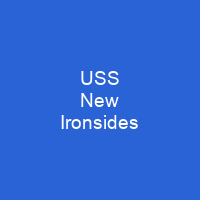USS New Ironsides: A Pioneering Ironclad in the American Civil War
Imagine a ship that could change the course of naval warfare—such was USS New Ironsides during the American Civil War.
The Birth and Design of USS New Ironsides
USS New Ironsides, named in honor of Old Ironsides, was a groundbreaking ship for its time. Built by Merrick & Sons in 1861, the contract for this ironclad cost $780,000—a hefty sum back then. The design was revolutionary; it featured a complete waterline belt of wrought iron that was 4.5 inches thick, with reduced thickness below the waterline. This armor was meant to protect the ship from enemy fire, but as we’ll see, it had its challenges.
From Hampton Roads to Charleston
New Ironsides initially sailed to Hampton Roads to join Rear Admiral Goldsborough’s fleet. However, problems with her steering, gun recoil, and speed led to delays and repairs. These issues were like a ship in a storm—hard to navigate and often unpredictable. Eventually, she joined the South Atlantic Blockading Squadron at Port Royal, South Carolina, where further modifications were made.
Blockade Running and Battles
The ship’s primary role was to blockade Confederate ports. In 1863-65, New Ironsides bombarded Charleston and Wilmington fortifications. These actions were like a relentless storm, battering the enemy’s defenses. The ship survived significant damage but lost crew members; eight received the Medal of Honor for their bravery under fire.
Key Battles and Achievements
New Ironsides participated in several key battles, including the First Battle of Charleston Harbor and the Second Battle of Fort Wagner. These engagements were crucial in capturing Fort Wagner on Morris Island. The ship was damaged multiple times during these battles but managed to remain operational. Between July and October 1863, New Ironsides fired 4,439 rounds and was hit by at least 150 heavy projectiles without significant damage or casualties.
Challenges and Innovations
The ship’s wooden carriages for 11-inch guns were too long and had to be replaced with iron carriages that pivoted at the gun ports. Two compressors were initially used but were not strong enough; additional compressors and rope breechings were added before strips of ash wood solved the problem. These innovations were like adding sails to a ship—necessary for progress.
Final Days and Legacy
New Ironsides was destroyed by fire in 1865 after being placed in reserve. The ship displaced 4,190 t with a designed displacement of 4,120 long tons, having a wide beam and flat bottom for minimal draft. It had a rectangular ram and a two-piece articulated rudder that proved unsatisfactory in service. These details paint a picture of a complex vessel that faced numerous challenges but played a significant role in the Union’s victory.
USS New Ironsides was more than just a ship; it was a symbol of innovation, resilience, and sacrifice during one of America’s most tumultuous periods. Its legacy lives on as a testament to the ingenuity and determination of those who served aboard her.

USS New Ironsides stands as a reminder of the transformative power of technology and the human spirit in times of conflict. Its story is one of perseverance, innovation, and the indomitable will to overcome adversity.
You want to know more about USS New Ironsides?
This page is based on the article USS New Ironsides published in Wikipedia (retrieved on November 28, 2024) and was automatically summarized using artificial intelligence.







